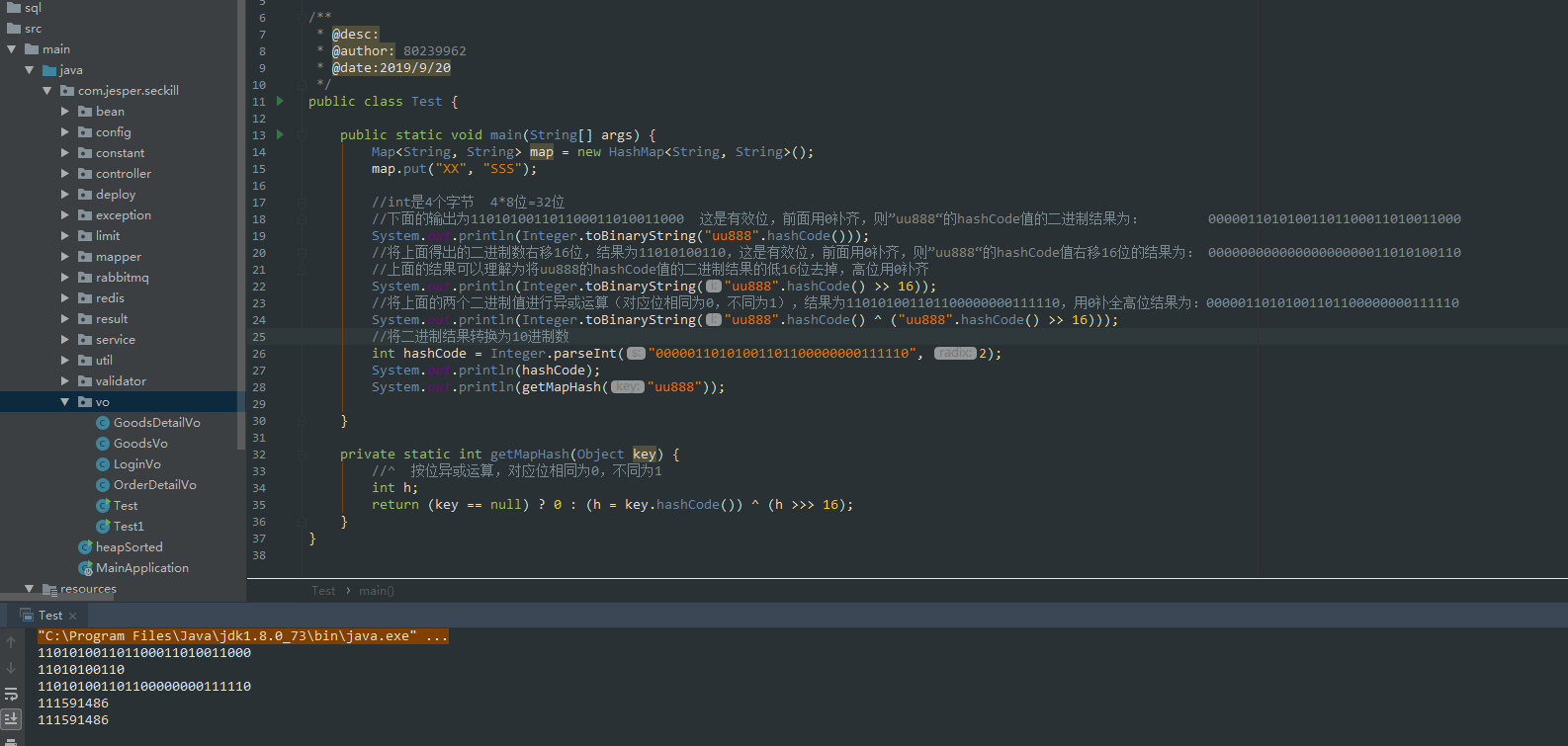HashMap是JDK提供的经典容器之一,最近刚好时间充裕,于是自己看了一遍hashMap的源码实现,不同版本的JDK,HashMap的实现方式有所不同,本文主要针对JDK1.8的源码进行分析,至于各版本实现方式的不同,本文不做讨论,下面直接开始。
一、hash函数分析
map的put方法,首先调用的就是hash函数,返回key的hash值,其函数方法如下:
static final int hash(Object key) {
int h;
return (key == null) ? 0 : (h = key.hashCode()) ^ (h >>> 16);
}
函数结构比较简单,但是我相信很多人看到这里是懵的,不知道函数这样处理的目的是什么,下面我写了一个小demo来帮助大家理解这个函数。
public class Test { public static void main(String[] args) { //int是4个字节 4*8位=32位 //下面的输出为110101001101100011010011000 这是有效位,前面用0补齐,则”uu888“的hashCode值的二进制结果为: 00000110101001101100011010011000 System.out.println(Integer.toBinaryString("uu888".hashCode())); //将上面得出的二进制数右移16位,结果为11010100110,这是有效位,前面用0补齐,则”uu888“的hashCode值右移16位的结果为: 00000000000000000000011010100110 //上面的结果可以理解为将uu888的hashCode值的二进制结果的低16位去掉,高位用0补齐 System.out.println(Integer.toBinaryString("uu888".hashCode() >> 16)); //将上面的两个二进制值进行异或运算(对应位相同为0,不同为1),结果为110101001101100000000111110,用0补全高位结果为:00000110101001101100000000111110 System.out.println(Integer.toBinaryString("uu888".hashCode() ^ ("uu888".hashCode() >> 16))); //将二进制结果转换为10进制数 int hashCode = Integer.parseInt("00000110101001101100000000111110", 2); System.out.println(hashCode); System.out.println(getHash("uu888")); } private static int getHash(Object key) { //^ 按位异或运算,对应位相同为0,不同为1 int h; return (key == null) ? 0 : (h = key.hashCode()) ^ (h >>> 16); } }
执行结果如下:

上面的结果只是为了验证我的推导过程的正确性,用Integer.toBinaryString()这个函数可以得到一个10进制数的二进制有效位,因为位运算都是基于二进制的,所以说明中我进行了补全,其实一句话说明就是,这个hash函数获取的就是key的hashCode的值的二进制数及其自身无符号右移16位之后的值的异或运算后的结果,至于为什么要这么做,主要是为了将这个二进制数(32位)的低16位和高16位打乱,使其散列尽可能均匀。
备注:右移16位,相当于将32位的二进制数的高16位移动到低16位,高16位用0补齐,可以根据我给的例子观察出来。
二、HashMap的put()方法源码注释分析
/**
* Implements Map.put and related methods
*
* @param hash hash for key ->存储key对应的hash值
* @param key the key ->存储的key
* @param value the value to put ->存储的value
* @param onlyIfAbsent if true, don't change existing value ->如果为true,仅当key不存在时添加,即不覆盖现有的值
* @param evict if false, the table is in creation mode. ->暂时不太理解用处,后面补充上~
* @return previous value, or null if none
*/
final V putVal(int hash, K key, V value, boolean onlyIfAbsent,
boolean evict) {
Node<K,V>[] tab;
Node<K,V> p;
int n, i;
if ((tab = table) == null || (n = tab.length) == 0) //table未初始化或者长度为0,调用resize()进行表(Node数组)的初始化 //resize()函数后面单独说明 n = (tab = resize()).length; if ((p = tab[i = (n - 1) & hash]) == null) //(n - 1) & hash等价于hash值对table长度取模,即通过hash获取存储数据的槽位 //尝试获取该槽位的节点值p且p为空,说明该槽位没有存放过数据,直接将put的数据存放在该槽位即可 tab[i] = newNode(hash, key, value, null); else { //该槽位已经存储了值,p不为空! Node<K,V> e; K k; if (p.hash == hash && ((k = p.key) == key || (key != null && key.equals(k)))) //判断p节点的key和put的key相等 将p赋值给e e = p; else if (p instanceof TreeNode) //p是红黑树节点,将新的key、value追加到树中 e = ((TreeNode<K,V>)p).putTreeVal(this, tab, hash, key, value); else { //p为单向链表,将新的key、value追加到链表尾部 for (int binCount = 0; ; ++binCount) { if ((e = p.next) == null) { //当e的下一个节点为空,说明当前的e就是链表尾节点 p.next = newNode(hash, key, value, null); if (binCount >= TREEIFY_THRESHOLD - 1) // -1 for 1st //链表长度达到TREEIFY_THRESHOLD=8,将链表转换为红黑树 treeifyBin(tab, hash); break; } if (e.hash == hash && ((k = e.key) == key || (key != null && key.equals(k)))) //在寻找尾节点的过程中找到了与put的key相同的key,停止尾节点寻找 break; p = e; } } if (e != null) { // existing mapping for key //key已经存在,根据onlyIfAbsent判断是否要用心的value替换老的value //onlyIfAbsent = false || oldValue == null 用新值替换老值 V oldValue = e.value; if (!onlyIfAbsent || oldValue == null) e.value = value; //节点修改完成后回调->扩展点,Callbacks to allow LinkedHashMap post-actions afterNodeAccess(e); return oldValue; } } ++modCount; if (++size > threshold) //新增后的元素个数>threshold,进行扩容 resize(); //节点新增后回调->扩展点 afterNodeInsertion(evict); return null; }
上面的分析过程中,有两处用到了resize函数,一是table未初始化的时候,一是新增元素后,如果元素总数size大于threshold的时,下面详细分析下这个函数。
三、HashMap扩容函数resize()方法源码注释分析
/**
* Initializes or doubles table size. If null, allocates in
* accord with initial capacity target held in field threshold.
* Otherwise, because we are using power-of-two expansion, the
* elements from each bin must either stay at same index, or move
* with a power of two offset in the new table.
*
* @return the table
*/
final Node<K,V>[] resize() {
//获取到老table的引用
Node<K,V>[] oldTab = table;
//获取老table的长度,如果未初始化,就是0
int oldCap = (oldTab == null) ? 0 : oldTab.length; //获取老table的阀值threshold int oldThr = threshold; //根据老table的长度和阀值获取新table的长度和阀值 int newCap, newThr = 0; if (oldCap > 0) { //如果老table的长度>0 if (oldCap >= MAXIMUM_CAPACITY) { //如果老table的长度>MAXIMUM_CAPACITY(1 << 30 = 1073741824,这个值也差不多是最大int值的一半), //将阀值threshold的值设置为Integer.MAX_VALUE(2147483647),返回老table threshold = Integer.MAX_VALUE; return oldTab; } else if ((newCap = oldCap << 1) < MAXIMUM_CAPACITY && //如果老table的长度<MAXIMUM_CAPACITY,那就将新的table长度赋值为老table长度的两倍(oldCap << 1 = oldCap*2) //如果这个两倍的新table长度小于MAXIMUM_CAPACITY并且满足老table长度>=DEFAULT_INITIAL_CAPACITY(1<<4=16) //则将新的阀值newThr扩展为老阀值的两倍 oldCap >= DEFAULT_INITIAL_CAPACITY) newThr = oldThr << 1; // double threshold } else if (oldThr > 0) // initial capacity was placed in threshold //如果老的阀值>0,新的数table长度用老的阀值代替 newCap = oldThr; else { // zero initial threshold signifies using defaults //map创建的时候会走这里! //新的table长度newCap为DEFAULT_INITIAL_CAPACITY(1<<4=16) //新的阀值大小newThr为(int)(DEFAULT_LOAD_FACTOR * DEFAULT_INITIAL_CAPACITY) = 0.75*16=12; newCap = DEFAULT_INITIAL_CAPACITY; newThr = (int)(DEFAULT_LOAD_FACTOR * DEFAULT_INITIAL_CAPACITY); } if (newThr == 0) { //如果新的阀值newThr为0,新的table长度*加载因子的值和新的table长度都小于MAXIMUM_CAPACITY(1073741824) //则新的阀值为(float)newCap * loadFactor,否则为Integer.MAX_VALUE(2147483647) float ft = (float)newCap * loadFactor; newThr = (newCap < MAXIMUM_CAPACITY && ft < (float)MAXIMUM_CAPACITY ? (int)ft : Integer.MAX_VALUE); } threshold = newThr; @SuppressWarnings({"rawtypes","unchecked"}) //根据上面计算出的新的table长度,初始化新的table,并将table指向新创建的table Node<K,V>[] newTab = (Node<K,V>[])new Node[newCap]; table = newTab; if (oldTab != null) { //如果老table不为空(即扩容操作),将老table的数据迁移到新的table for (int j = 0; j < oldCap; ++j) { Node<K,V> e; if ((e = oldTab[j]) != null) { //将老table的对应位置赋值为空 oldTab[j] = null; if (e.next == null) //对应位置只有一个数据,直接寻找到该数据在新的table的槽位赋值即可 //(e.hash & (newCap - 1)即取模运算) newTab[e.hash & (newCap - 1)] = e; else if (e instanceof TreeNode) //对应位点是红黑树,将该位点的红黑树重建 ((TreeNode<K,V>)e).split(this, newTab, j, oldCap); else { // preserve order //对应位点是普通单向链表,对该链表的元素遍历进行重新hash分布 Node<K,V> loHead = null, loTail = null; //存放索引位置不变的元素, loHead用来标记链表,loTail用来拼接链表 Node<K,V> hiHead = null, hiTail = null; //存放索引位置为当前位置j+oldCap的元素, hiHead用来标记链表,hiTail用来拼接链表 Node<K,V> next; do { next = e.next; if ((e.hash & oldCap) == 0) { //e.hash & oldCap代表新索引和原始索引一样 if (loTail == null) //loTail为空 loHead->e 头指针指向第一个元素 loHead = e; else //尾指针不为空,将当前元素放在尾指针后面 loTail.next = e; //移动尾指针指向当前元素,即链表的最后有一个元素 loTail = e; } else { if (hiTail == null) hiHead = e; else hiTail.next = e; hiTail = e; } } while ((e = next) != null); if (loTail != null) { //尾指针元素存在,说明链表不为空 //将尾部元素的下一个元素赋值为空,并将链表放到位置为j的桶中 loTail.next = null; newTab[j] = loHead; } if (hiTail != null) { hiTail.next = null; newTab[j + oldCap] = hiHead; } } } } } return newTab; }
三、HashMap的get()方法源码注释分析
/**
* Implements Map.get and related methods.
*
* @param hash hash for key
* @param key the key
* @return the node, or null if none
*/
final Node<K,V> getNode(int hash, Object key) {
Node<K,V>[] tab;
Node<K,V> first, e;
int n; K k;
if ((tab = table) != null && (n = tab.length) > 0 &&
(first = tab[(n - 1) & hash]) != null) { //首先通过hash对table长度n取模([(n - 1) & hash并获取第一个元素引用first if (first.hash == hash && // always check first node ((k = first.key) == key || (key != null && key.equals(k)))) //第一个元素就是要查询的值,直接返回!! return first; if ((e = first.next) != null) { if (first instanceof TreeNode) //该槽位的节点是红黑树,从红黑树中查询返回 return ((TreeNode<K,V>)first).getTreeNode(hash, key); do { //该槽位是普通链接,遍历链表查询返回 if (e.hash == hash && ((k = e.key) == key || (key != null && key.equals(k)))) return e; } while ((e = e.next) != null); } } return null; }
以上就是HashMap几个重要函数的源码分析,当然还有比较棘手的红黑树的处理,下次再专门写一篇文章说明。